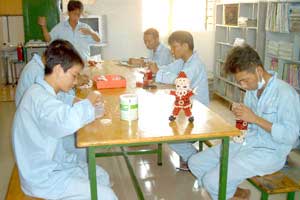The symptoms of AIDS closely resemble the signs of tuberculosis as described in traditional medicine. Based on this observation, the Central Traditional Medicine Hospital is conducting Phase 2 clinical trials of several traditional herbal remedies to support the treatment of HIV/AIDS.
 |
|
AIDS patients in the advanced stage participating in labor at the Compassion Hospital |
According to Dr. Chu Quoc Truong from the Central Institute of Traditional Medicine, in traditional medicine, tuberculosis is viewed as a state of immune deficiency, reduced resistance, and general debilitation due to specific causes. Based on the stage of the disease, doctors prescribe corresponding herbal remedies to help the body combat the illness. The same principle applies to the supportive treatment for AIDS patients.
In the early stage, when the pathogenic factors just invade the body and the vital energy is still dominant, the necessary treatment principle is to expel the pathogens. The herbal remedy used at this stage has effects such as clearing heat and detoxifying the body, including: honeysuckle, skullcap, dandelion, fish mint, and heartleaf, combined to nourish yin, moisten dryness, and boost vital energy. For AIDS patients, this remedy helps prevent the spread of the virus within the body and supports a longer healthy life.
As the disease progresses to the second stage, the pathogenic factors gain the upper hand while the vital energy diminishes. At this point, the traditional medicine perspective is to reinforce the vital energy, meaning efforts are made to enhance the body’s resistance, and to expel the pathogens, meaning limiting and preventing the invasion of pathogens. This remedy includes: astragalus, codonopsis, Chinese yam, goji berries, white atractylodes, and coix seed. This medicine helps patients slow the destructive potential of the HIV virus on the body.
When the balance of qi and blood, and yin and yang is severely compromised, the disease has reached its final stage. A warming and nourishing remedy is required, consisting of: earthworm seed, five-flavor berry, rehmannia, eucommia, and epimedium, to help patients endure suffering and pain and prolong life. HIV patients often experience blood stasis, so traditional medicine also utilizes salvia, angelica, turmeric, peony, and red sandalwood to improve blood circulation.
Dr. Truong stated that although these herbal remedies are still in Phase 2 of the research process, they show great promise. They are currently being tested on 38 AIDS patients at the Infectious Disease Department of Dong Da Hospital in Hanoi. Results indicate that the medicine helps enhance resistance and boosts the immune system, evidenced by increases in TCD4 and TCD8 immune indicators. Symptoms such as weight loss, loss of appetite, and skin lesions have improved compared to untreated individuals. Soon, these herbal remedies will be tested for treating AIDS patients at the Tropical Disease Hospital in Ho Chi Minh City.
The application of traditional medicine is a new and promising trend in the supportive treatment of AIDS. Many places around the world have also researched and tested similar methods, yielding positive results. For instance, the Jiangsu Traditional Medicine Academy in Hong Kong identified over 32 herbal species that inhibit HIV. Tanzania has utilized decoctions of multi-ingredient formulas (ESL) to treat 256 HIV/AIDS cases continuously for 8 years, resulting in nearly 90% of patients experiencing improved clinical symptoms and enhanced quality of life. In China, extracts from licorice have been applied to 60 late-stage AIDS patients with very low TCD4 immune counts. After 150 days of treatment, immune function improved by over 60%, Dr. Truong added.
However, for these remedies to gain recognition and approval from the Ministry of Health for widespread use in supportive treatment for AIDS, they must undergo several more phases of research.
My Lan


















































